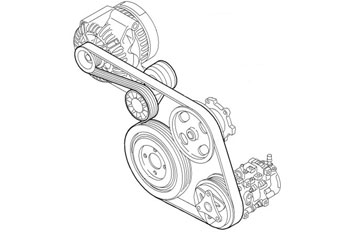How to check Auxilliary Drive belt
- Rohit Chaubal
- Aug 3, 2023
- 2 min read
How to check Auxilliary Drive belt

The auxiliary drive belt is also known as the serpentine belt, and runs all the auxiliary systems on the front of the motor. It shouldn't be confused with the timing belt which serves a completely different purpose.
The auxiliary belt's role is to transmit power to a variety of important peripheral components via a system of pulleys driven by the engine's crankshaft pulley. This one belt turns the alternator, water pump, air conditioning compressor, and sometimes the power steering pump and the cooling fan.
On old cars there were typically two or three v-shaped belts that connected the crankshaft pulley with these accessories so as the engine rotated so did they. This could take up several inches of space between the engine and the radiator or fender (depending on if it was transverse or longitudinally mounted).

In recent years the serpentine belt has become the preferred choice. Its wide, flat, multi-ribbed design can power several different components and takes up less space. With careful engineering, some accessories can be turned with less friction from the back of the belt, for greater fuel economy.
Where is the drive belt?
On most front-wheel drive cars you typically see the auxiliary belt on the passenger side of the engine (access may be very tight). Unlike the timing belt which is usually 'hidden' behind a cover, the serpentine belt is usually easy to spot.
On rear-wheel drive cars you'll see the drive belt right up on the front of the engine.
What is a drive belt made of?
The belts are made of reinforced rubber and usually ribbed on one side. It's interesting to note that as the belt snakes its way around the various pulleys both the ribbed side of the belt and the smooth side apply friction to the different pulleys depending on the level of 'load' they place on the belt.
How do you check the drive belt?
Just like the old V-belts, any check should start with examining both sides (the flat and the ribbed) for cracks and shiny spots, which indicate a slipping belt. Also, check for oil, coolant, and power steering fluid contamination of the belt; some chemicals can rapidly degrade the rubber.
As the belt starts to wear out, sometimes the reinforcing fibers inside will start to come out and whip around, tangling things up.
As the belt needs to be really quite long you're also likely to find an idler pulley, and/or a tensioner pulley in the mix. These keep the belt correctly tensioned so it doesn't deviate from its course, and so that it applies sufficient friction to the pulleys. With the engine off, try to push the tensioner back, and check the idlers for play. The belt should have just enough deflection in its longest run between pulleys to twist 90 degrees.
How often should you check the drive belt?
Haynes recommends on most vehicles, that you look over the serpentine belt every time you change the oil. If the belt fails it typically isn't catastrophic, but your car will quickly overheat after a few miles without the water pump turning. You should plan on changing the belt every five years of 60,000 miles even if it looks okay. Replacements are inexpensive and they typically only require a few minutes to change.






.png)



Comments